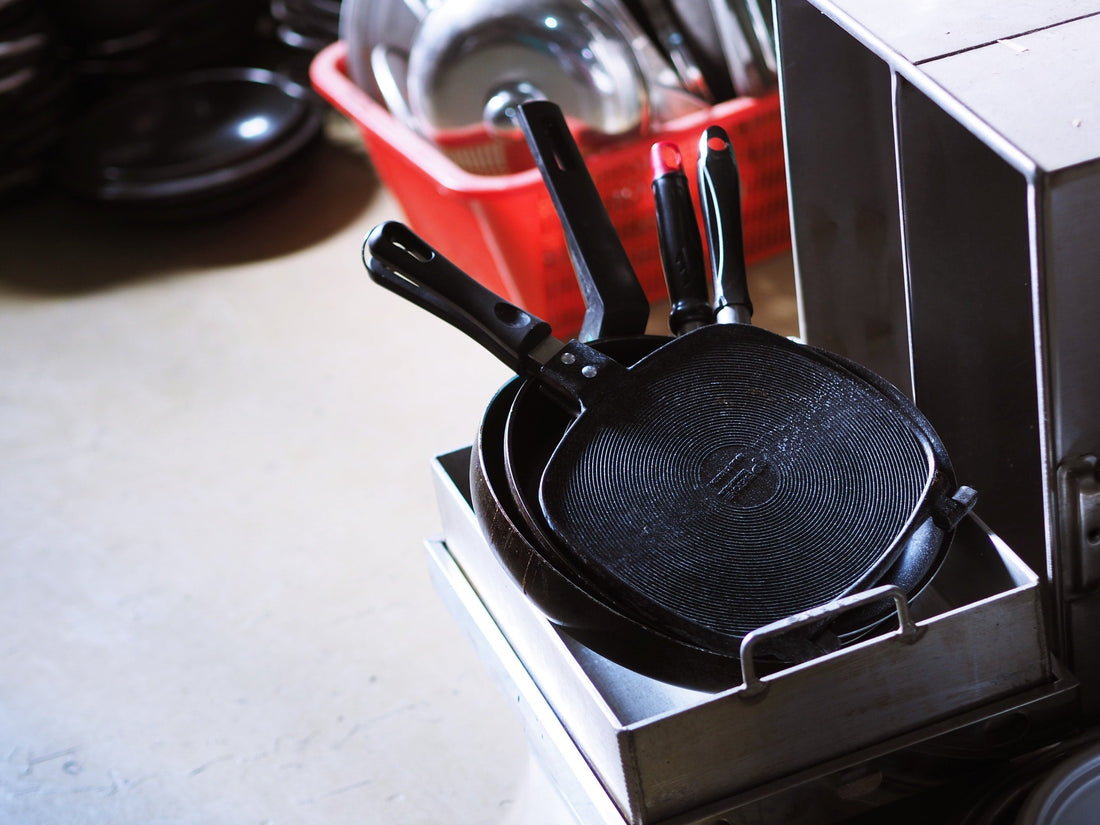
We’ve all been there: a momentary distraction or misjudged heat dial, and suddenly your favourite frying pan is scorched and smoking. Whether it’s a baked-on omelette or a pot boiled dry, have no fear — here are some top tips on how to clean a burnt pan.
Is a burnt pan ruined?
A burnt pan can be frustrating, particularly if you’ve spent a lot of money investing in a kitchenware set. You might wonder what to do with this ruined pan. Will it have to go in the bin? Can it be recycled? The good news is that, with a little elbow grease and a clever cleaning concoction, it’s possible to rescue your pans.
Some burnt pans are easier to fix than others, and different materials require different solutions. With a bit of patience and the right technique, your pans will live to cook another day.
General cleaning tips for burnt pans

You don’t need any fancy sprays to salvage a burnt pan. Some of the best ingredients for tackling tough burns can be found around the house — lemon, vinegar, and baking soda are top choices. As you’ll see, some techniques are better suited to certain pan materials.
It might be tempting to jump straight to the most abrasive solution. But, to avoid scratching the pan’s surface, it’s best to start with the gentlest cleaning method first and work your way up to the stronger fixes if needed.
It’s important to always let the pan cool before you attempt to clean it. And when looking at how to clean a burnt pan, consider the type of burn you’re facing. A pan that has been left on the hob and scorched dry will need a different technique to a pan with a substantial amount of ingredients stuck to it.
When you’re battling a crust of food, like scrambled egg or welded-on melted cheese, try to scrape off as much of the debris as possible first. Then you can get to work your magic on the stained metal beneath.
How to clean a burnt non-stick pan
You may be wary of scrubbing away at a non-stick pan — won’t it damage the surface? When tackling a burnt non-stick pan, stay away from steel wool and other rough sponges that may scratch through the stick-proof layer.
Some non-stick pans, including the Zyliss Ultimate Non-stick range, are dishwasher-safe. However, when cleaning burnt pans, it may be best to wash them by hand so you can target the affected areas.
White vinegar is an excellent solution for salvaging burnt non-stick pans. Once the pan has cooled, pour in a generous glug of white vinegar, along with enough warm water to cover the burnt areas. Stir in two tablespoons of baking soda, heat the mixture up, and bring it to a boil for a couple of minutes. Use a wooden spoon or silicone spatula (avoid metal utensils) to remove as much of the burnt substance as possible.
Leave the pan to cool, then pour away the dirty mixture. Any burnt-on food should come off with it, and you can wipe the remaining grease stains with a cloth.
For more stubborn stains, you may need to repeat the process and leave the mixture to simmer for longer before taking the pan off the heat.
How to clean a burnt stainless steel pan

Stainless steel pans are pretty hardy and can handle a bit more scrubbing than non-stick pans. The most effective tool for the job may surprise you — a simple scrunched up ball of aluminium foil! Combine with baking soda, and you’ve got a quick and easy solution for cleaning a burnt stainless steel pan.
Once the used pan has cooled, sprinkle two to three tablespoons of baking soda over the burnt area and add a small amount of water to form a paste. Crumple up your tin foil (any piece will do, even if it’s been used) and scrub until you’ve loosened all the debris and any staining.
Rinse the pan with warm soapy water, et voila, your stainless steel pan will be gleaming.
Lemons are another fantastic option for stainless steel pans, especially for burnt-on eggs and noodles. Cut up a couple of lemons — three if there’s a lot of damage — and pop them in your pan with enough water to cover the bottom of the pan and the lemons. Boil for five to ten minutes.
Once food particles start rising to the surface, you can get rid of the water and lemons and use a regular scouring pad to get any last bits. Once rinsed, your pan should be good as new. Plus, your kitchen will be filled with a fresh lemony scent, too.
How to clean a burnt cast iron pan
As with non-stick cookware, cast iron pans are sensitive to abrasive sponges, which can remove the pan’s seasoning.
Think of cleaning a burnt cast iron pan as exfoliation. Rather than scrubbing with steel wool or rough scouring pads, go for a gentler sea salt rub. Use a soft cloth to massage salt into the pan’s surface to loosen any burnt-on food. This method requires a little bit of patience but will mean your cast iron pan or skillet is ready and raring to go for its next cooking adventure.
Once all the burnt stuff has been loosened, rinse the pan under warm running water to get rid of the debris. It’s really important to make sure your pan is properly dried after washing, as water can cause cast iron to rust. After drying, add a good layer of oil to season your cast iron pan, then it’s ready to put away.
Accidents happen, and sometimes a burnt pan is inevitable. Fortunately, everyday household ingredients can offer cleaning solutions.
Choosing high-quality non-stick cookware, like Zyliss Ultimate Non-stick and Superior Ceramic pans, reduces the risk of burnt-on food in the first place. Their innovative stick-resistant surfaces can withstand high temperatures and prevent ingredients from clinging on.

